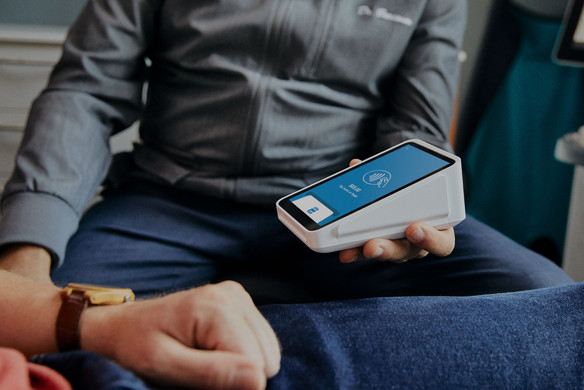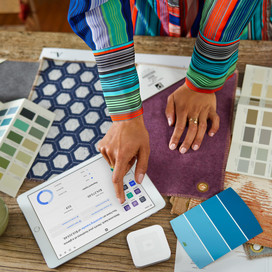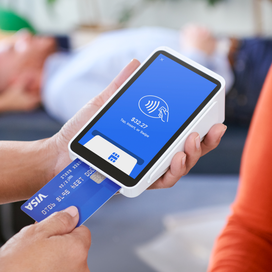Table of contents
Disclaimer: This article is for educational purposes and does not constitute legal, financial, or tax advice. For specific advice applicable to your business, please contact a professional.
As a healthcare provider, whether you heal broken bones or broken hearts, your work is important. And so is getting paid for what you do. That’s why taking payments at your medical practice is a crucial aspect of your business.
As the healthcare and insurance industries evolve, patients are paying more out of pocket. Out-of-pocket spending grew 6.6% to $471.4 billion in 2022 and is showing no signs of slowing down.
To ensure easy, safe payments from patients, a solid healthcare payment system is crucial to keeping medical practices healthy and revenue flowing. The chances of collecting payment drop by 62% once a patient leaves your office. To avoid missing out on copays or other charges, make it easy for patients to pay at the front desk, catch them before they head out, or allow them to prepay before appointments.
Healthcare payment processing at your practice
Giving your patients multiple ways to pay is crucial to ensuring timely payment. Patients’ desire for omnichannel payment experiences has grown. This means that they are looking for different ways to pay — online, in app, or in the office.
To meet this need, it’s essential to have a versatile healthcare payment system. You may choose to provide an app for intake forms and copay payments or bring a mobile credit card reader directly into the exam room for their convenience.
Pro tip: Whatever your payment solution, ensure that the experience is the same however patients opt to pay — in person, in app, or from an invoice.
How to take payments with your healthcare payment system
1. Before the appointment
To improve your customer experience and reduce wait times, encourage patients to fill out forms and pay the copay before coming into the office, using a solution like the Square and IntakeQ integration.
The integration allows you to easily build custom forms and take payments on Square (and IntakeQ is PCI DSS Service Provider Level I compliant and HIPAA compliant), so when the patient arrives, they’ve already completed the necessary forms and paid their copay.
To integrate IntakeQ with your Square account, simply follow these steps:
1. Visit the App integrations section of your online Square Dashboard > click Visit App Marketplace.
2. Search for IntakeQ in the search bar > click Search.
3. Under IntakeQ, click Get Started.
4. Allow permissions to access your Square account information.
2. At the front desk
To easily process payments at your front desk before or after an appointment, opt for sleek hardware that complements your office, like Square Terminal. You can also swipe cards on your office computer using Square Virtual Terminal.
Using Square Terminal, easily accept payments by allowing clients to either dip a chip card, tap a contactless card or device, or swipe a magstripe card.
Using Square Virtual Terminal, you can take payments from clients directly from your computer. Take payments in-person at the office by pairing Square Terminal to your computer, remotely (by phone, email, or text message), or using the Square Charge for Desktop app (currently only available for Mac computers).
3. In the exam room
If you want a mobile option to take payments in an exam room or office for privacy or ease (pediatricians, looking at you), you may opt to go for a mobile payment solution. You’ll be able to bring the payments right to a patient by taking payments on Square Terminal.
Dr. Jonathan Kaplan, owner of Pacific Heights Plastic Surgery in San Francisco, uses Square Terminal to take payments at his practice. “The ability to take a sleek, bulletproof, dependable device into the exam room to charge the patient in private has upped our customer service game,” he says. “Now we can avoid the awkwardness of charging the patient at the front desk with everyone in the waiting room overhearing how much they spent.”
Square Terminal is optimized for easy, professional, and reliable payments that treat you and your money fairly, with no long-term contracts, hidden fees, or confusing hardware agreements.
With Square Terminal, you’ll pay one low, transparent, and fair transaction rate of 2.6% + 15¢ for every dip, tap, or swipe payment, and $299 for the device. You’ll also have 24/7 phone support and next-business-day hardware replacement.
4. Take payments after the appointment.
Your practice may opt to collect patient payments outside of the office. This is doable with an online invoice or through integration with a form-building app like IntakeQ or Dr. Chrono (Dr. Chrono also has the capability of keeping patient cards on file). And if none of these solutions best fit your practice, your developer can build a custom solution with our payment API or payment SDK.
What else should healthcare practices consider?
Healthcare practices and their healthcare payment systems must comply with specific requirements when it comes to managing patient information. Specifically, medical practices in the United States must comply with HIPAA when managing patient information and payment data.
If you are subject to HIPAA as a covered entity or business associate and use Square to process payments, you’ll need to agree to the HIPAA Business Associate Agreement (HIPAA BAA). Under the HIPAA BAA, Square helps facilitate your HIPAA compliance.
One of the biggest concerns for the healthcare industry when choosing a payment processor is the security and privacy of sensitive information. Billing details, often intertwined with protected health information (PHI), require stringent protections to comply with healthcare regulations such as HIPAA. With Square, every piece of PHI handled during the billing process is encrypted and securely processed.
Square simplifies compliance by providing features specifically designed to protect PHI, ensuring that healthcare providers can focus on patient care without worrying about the details around data security. Our comprehensive approach includes:
- End-to-end encryption: Safeguarding data from the point of entry to the final processing stages
- Access controls and audit trails: Allowing only authorized personnel access to sensitive information and tracking all data interactions
- Regular security assessments: Continuously evaluating and enhancing security measures to keep up with evolving threats
As a merchant of record, Square takes data security seriously. When your patient pays, our proprietary tokenization scheme ensures that unencrypted payment data never touches your device or application. Learn more about how Square protects your business and your patients’ payment information.
On February 25, 2025, Square updated its in-person payment rate to 2.6% + 15¢. Learn more about Square’s fees here.
![]()












